Synthesis and Characterization of Gamma Radiation Induced Diallyldimethylammonium Chloride-Acrylic Acid-(3-Acrylamidopropyl) Trimethylammonium Chloride Superabsorbent Hydrogel
Abstract
1. Introduction
2. Results and Discussion
2.1. Radiation Polymerization of DADMAC-AAc-APTAC
2.2. Effect of Radiation Dose on APTAC-AAc-DADMAC Gel Content
2.3. Effect of Radiation Dose on Equilibrium Swelling of Gels
2.4. Characterization of Hydrogel by FTIR Spectroscopy
2.5. X-ray Diffraction Analysis
2.6. Nuclear Magnetic Resonance (NMR) Spectroscopy
2.7. Thermogravimetric Analysis (TGA)
2.8. Surface Analysis by SEM-EDS
3. Conclusions
4. Materials and Methods
4.1. Materials and Reagents
4.2. Apparatus and Instruments
4.3. Synthesis of DADMAC-AAc-APTAC Hydrogels by Gamma Radiation
4.4. Post-Synthesis Analysis
4.4.1. Extraction and Measurement of Gel Content
4.4.2. Measurement of Super-Absorbency at Equilibrium Swelling
Author Contributions
Funding
Institutional Review Board Statement
Informed Consent Statement
Data Availability Statement
Acknowledgments
Conflicts of Interest
References
- Ullah, F.; Othman, M.B.H.; Javed, F.; Ahmad, Z.; Akil, H.M. Classification, Processing and Application of Hydrogels: A Review. Mater. Sci. Eng. C 2015, 57, 414–433. [Google Scholar] [CrossRef]
- Zhao, X.; Huang, Y.; Tian, X.; Luo, J.; Wang, H.; Wang, J.; Chen, Y.; Jia, P. Polysaccharide-Based Adhesive Antibacterial and Self-Healing Hydrogel for Sealing Hemostasis. Biomacromolecules 2022, 23, 5106–5115. [Google Scholar] [CrossRef]
- Gharekhani, H.; Olad, A.; Mirmohseni, A.; Bybordi, A. Superabsorbent Hydrogel Made of NaAlg-g-Poly(AA-Co-AAm) and Rice Husk Ash: Synthesis, Characterization, and Swelling Kinetic Studies. Carbohydr. Polym. 2017, 168, 1–13. [Google Scholar] [CrossRef]
- Darwish, A.; El-Sayed, N.S.; Al Kiey, S.A.; Kamel, S.; Turky, G. Polyanionic Electrically Conductive Superabsorbent Hydrogel Based on Sodium Alginate-g-Poly (AM-Co-ECA-Co-AMPS): Broadband Dielectric Spectroscopy Investigations. Int. J. Biol. Macromol. 2023, 232, 123443. [Google Scholar] [CrossRef]
- Varaprasad, K.; Raghavendra, G.M.; Jayaramudu, T.; Yallapu, M.M.; Sadiku, R. A Mini Review on Hydrogels Classification and Recent Developments in Miscellaneous Applications. Mater. Sci. Eng. C 2017, 79, 958–971. [Google Scholar] [CrossRef]
- Richbourg, N.R.; Peppas, N.A. The Swollen Polymer Network Hypothesis: Quantitative Models of Hydrogel Swelling, Stiffness, and Solute Transport. Prog. Polym. Sci. 2020, 105, 101243. [Google Scholar] [CrossRef]
- Călina, I.; Demeter, M.; Scărișoreanu, A.; Micutz, M. Development of Novel Superabsorbent Hybrid Hydrogels by E-beam Crosslinking. Gels 2021, 7, 189. [Google Scholar] [CrossRef]
- Bhuyan, M.M.; Adala, O.B.; Okabe, H.; Hidaka, Y.; Hara, K. Selective Adsorption of Trivalent Metal Ions from Multielement Solution by Using Gamma Radiation-Induced Pectin-Acrylamide-(2-Acrylamido-2-Methyl-1-Propanesulfonic Acid) Hydrogel. J. Environ. Chem. Eng. 2019, 7, 102844. [Google Scholar] [CrossRef]
- Hoffman, A.S. Hydrogels for Biomedical Applications. Adv. Drug Deliv. Rev. 2012, 64, 18–23. [Google Scholar] [CrossRef]
- Qu, B.; Luo, Y. Chitosan-Based Hydrogel Beads: Preparations, Modifications and Applications in Food and Agriculture SectorsA Review. Int. J. Biol. Macromol. 2020, 152, 437–448. [Google Scholar] [CrossRef]
- Lu, Y.C.; Song, W.; An, D.; Kim, B.J.; Schwartz, R.; Wu, M.; Ma, M. Designing Compartmentalized Hydrogel Microparticles for Cell Encapsulation and Scalable 3D Cell Culture. J. Mater. Chem. B 2015, 3, 353–360. [Google Scholar] [CrossRef]
- Bae, J.; Park, J.; Kim, S.; Cho, H.; Kim, H.J.; Park, S.; Shin, D.S. Tailored Hydrogels for Biosensor Applications. J. Ind. Eng. Chem. 2020, 89, 1–12. [Google Scholar] [CrossRef]
- Mistry, P.A.; Konar, M.N.; Latha, S.; Chadha, U.; Bhardwaj, P.; Eticha, T.K. Chitosan Superabsorbent Biopolymers in Sanitary and Hygiene Applications. Int. J. Polym. Sci. 2023, 2023, 4717905. [Google Scholar] [CrossRef]
- Shah, S.S.; Ramos, B.; Teixeira, A.C.S.C. Adsorptive Removal of Methylene Blue Dye Using Biodegradable Superabsorbent Hydrogel Polymer Composite Incorporated with Activated Charcoal. Water 2022, 14, 3313. [Google Scholar] [CrossRef]
- Bhuyan, M.M.; Jophous, M.; Jeong, J.H. Synthesis and Characterization of Gamma Radiation-Induced (3-Acrylamidopropyl) Trimethylammonium Chloride-Acrylic Acid Functional Superabsorbent Hydrogel. Polym. Bull. 2022, 1–14. [Google Scholar] [CrossRef]
- Sahiner, N.; Demirci, S.; Sahiner, M.; Yilmaz, S.; Al-Lohedan, H. The Use of Superporous p(3-Acrylamidopropyl) Trimethyl Ammonium Chloride Cryogels for Removal of Toxic Arsenate Anions. J. Environ. Manag. 2015, 152, 66–74. [Google Scholar] [CrossRef]
- Sennakesavan, G.; Mostakhdemin, M.; Dkhar, L.K.; Seyfoddin, A.; Fatihhi, S.J. Acrylic Acid/Acrylamide Based Hydrogels and Its Properties—A Review. Polym. Degrad. Stab. 2020, 180, 109308. [Google Scholar] [CrossRef]
- Korpe, S.; Erdoǧan, B.; Bayram, G.; Ozgen, S.; Uludag, Y.; Bicak, N. Crosslinked DADMAC Polymers as Cationic Super Absorbents. React. Funct. Polym. 2009, 69, 660–665. [Google Scholar] [CrossRef]
- Pirgalioğlu, S.; Özbelge, T.A.; Özbelge, H.Ö.; Bicak, N. Crosslinked PolyDADMAC Gels as Highly Selective and Reusable Arsenate Binding Materials. Chem. Eng. J. 2015, 262, 607–615. [Google Scholar] [CrossRef]
- Hebeish, A.; Sharaf, S. Novel Nanocomposite Hydrogel for Wound Dressing and Other Medical Applications. RSC Adv. 2015, 5, 103036–103046. [Google Scholar] [CrossRef]
- Balea, A.; Fuente, E.; Concepcion Monte, M.; Merayo, N.; Campano, C.; Negro, C.; Blanco, A. Industrial Application of Nanocelluloses in Papermaking: A Review of Challenges, Technical Solutions, and Market Perspectives. Molecules 2020, 25, 526. [Google Scholar] [CrossRef] [PubMed]
- Tang, Z.; Guo, H.; Xu, J.; Li, Z.; Sun, G. Cationic Poly(Diallyldimethylammonium Chloride) Based Hydrogel for Effective Anionic Dyes Adsorption from Aqueous Solution. React. Funct. Polym. 2022, 174, 105239. [Google Scholar] [CrossRef]
- Mrohs, T.B.; Weichold, O. Multivalent Allylammonium-Based Cross-Linkers for the Synthesis of Homogeneous, Highly Swelling Diallyldimethylammonium Chloride Hydrogels. Gels 2022, 8, 100. [Google Scholar] [CrossRef] [PubMed]
- Li, C.; Duan, L.; Cheng, X. Facile Method to Synthesize Fluorescent Chitosan Hydrogels for Selective Detection and Adsorption of Hg2+/Hg+. Carbohydr. Polym. 2022, 288, 119417. [Google Scholar] [CrossRef]
- Gulrez, H.S.K.; Al-Assaf, S.; Phillips, O.G. Hydrogels: Methods of Preparation, Characterisation and Applications. Prog. Mol. Environ. Bioeng.-Anal. Model. Technol. Appl. 2011, 117150. [Google Scholar] [CrossRef]
- Singhal, R.; Tomar, R.S.; Nagpal, A.K. Effect of Cross-Linker and Initiator Concentration on the Swelling Behaviour and Network Parameters of Superabsorbent Hydrogels Based on Acrylamide and Acrylic Acid. Int. J. Plast. Technol. 2009, 13, 22–37. [Google Scholar] [CrossRef]
- Bhat, R.; Karim, A.A. Impact of Radiation Processing on Starch. Compr. Rev. Food Sci. Food Saf. 2009, 8, 44–58. [Google Scholar] [CrossRef]
- Bhuyan, M.M.; Okabe, H.; Hidaka, Y.; Hara, K. Pectin-[(3-Acrylamidopropyl) Trimethylammonium Chloride-Co-Acrylic Acid] Hydrogel Prepared by Gamma Radiation and Selectively Silver (Ag) Metal Adsorption. J. Appl. Polym. Sci. 2018, 135, 45906. [Google Scholar] [CrossRef]
- Takahashi, S.; Okonogi, H.; Hagiwara, T.; Maekawa, Y. Preparation of Polymer Electrolyte Membranes Consisting of Alkyl Sulfonic Acid for a Fuel Cell Using Radiation Grafting and Subsequent Substitution/Elimination Reactions. J. Memb. Sci. 2008, 324, 173–180. [Google Scholar] [CrossRef]
- Haleem, A.; Chen, J.; Guo, X.X.; Hou, S.C.; Chen, S.Q.; Siddiq, M.; He, W.D. Radiation-Induced Synthesis of Hydrophobic Cryogels with Rapid and High Absorption of Organic Solvents and Oils. Microporous Mesoporous Mater. 2022, 330, 111486. [Google Scholar] [CrossRef]
- Zheng, H.; Feng, L.; Gao, B.; Zhou, Y.; Zhang, S.; Xu, B. Effect of the Cationic Block Structure on the Characteristics of Sludge Flocs Formed by Charge Neutralization and Patching. Materials 2017, 10, 487. [Google Scholar] [CrossRef]
- Zan, X.; Kozlov, M.; McCarthy, T.J.; Su, Z. Covalently Attached, Silver-Doped Poly(Vinyl Alcohol) Hydrogel Films on Poly(l -Lactic Acid). Biomacromolecules 2010, 11, 1082–1088. [Google Scholar] [CrossRef]
- Jing, R.; Yanqun, Z.; Jiuqiang, L.; Hongfei, H. Radiation Synthesis and Characteristic of IPN Hydrogels Composed of Poly(Diallyldimethylammonium Chloride) and Kappa-Carrageenan. Radiat. Phys. Chem. 2001, 62, 277–281. [Google Scholar] [CrossRef]
- Zahib, I.R.; Md Tahir, P.; Talib, M.; Mohamad, R.; Alias, A.H.; Lee, S.H. Effects of Degree of Substitution and Irradiation Doses on the Properties of Hydrogel Prepared from Carboxymethyl-Sago Starch and Polyethylene Glycol. Carbohydr. Polym. 2021, 252, 117224. [Google Scholar] [CrossRef]
- Mohamad, N.; Buang, F.; Mat Lazim, A.; Ahmad, N.; Martin, C.; Mohd Amin, M.C.I. Characterization and Biocompatibility Evaluation of Bacterial Cellulose-Based Wound Dressing Hydrogel: Effect of Electron Beam Irradiation Doses and Concentration of Acrylic Acid. J. Biomed. Mater. Res.-Part B Appl. Biomater. 2017, 105, 2553–2564. [Google Scholar] [CrossRef]
- Ardeshiri, F.; Akbari, A.; Peyravi, M.; Jahanshahi, M. PDADMAC/PAA Semi-IPN Hydrogel-Coated PVDF Membrane for Robust Anti-Wetting in Membrane Distillation. J. Ind. Eng. Chem. 2019, 74, 14–25. [Google Scholar] [CrossRef]
- Yuan, Y.; Shen, C.; Chen, J.; Ren, X. Synthesis and Characterization of Cross-Linked Quaternized Chitosan/Poly (Diallyldimethylammonium Chloride) Blend Anion-Exchange Membranes. Ionics 2018, 24, 1173–1180. [Google Scholar] [CrossRef]
- Dashtimoghadam, E.; Salimi-Kenari, H.; Forooqi Motlaq, V.; Hasani-Sadrabadi, M.M.; Mirzadeh, H.; Zhu, K.; Knudsen, K.D.; Nyström, B. Synthesis and Temperature-Induced Self-Assembly of a Positively Charged Symmetrical Pentablock Terpolymer in Aqueous Solutions. Eur. Polym. J. 2017, 97, 158–168. [Google Scholar] [CrossRef]
- Constantin, M.; Mihalcea, I.; Oanea, I.; Harabagiu, V.; Fundueanu, G. Studies on Graft Copolymerization of 3-Acrylamidopropyl Trimethylammonium Chloride on Pullulan. Carbohydr. Polym. 2011, 84, 926–932. [Google Scholar] [CrossRef]
- Abd El-Ghany, N.A.; Mahmoud, Z.M. Synthesis, Characterization and Swelling Behavior of High-Performance Antimicrobial Amphoteric Hydrogels from Corn Starch. Polym. Bull. 2021, 78, 6161–6182. [Google Scholar] [CrossRef]
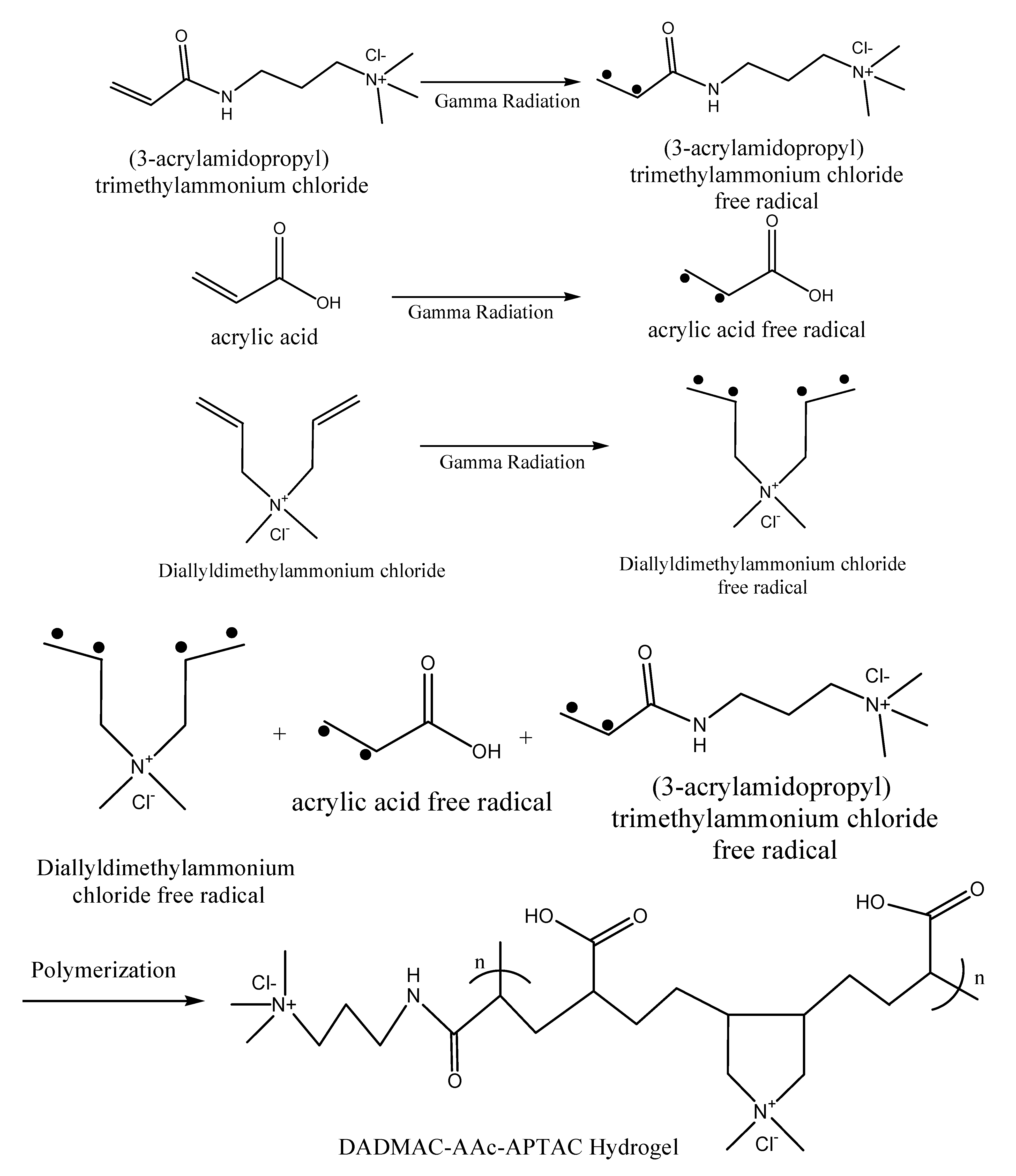
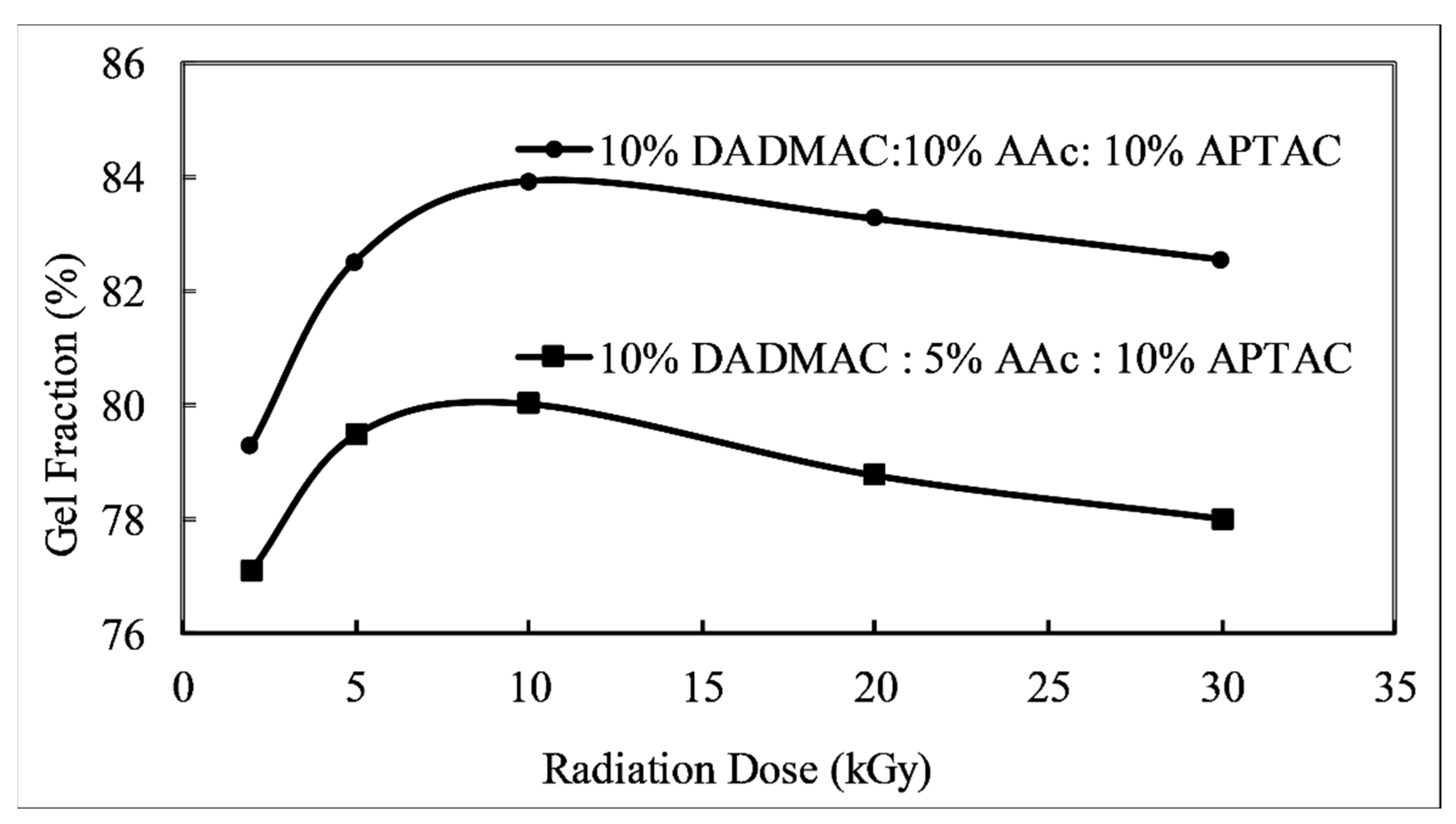

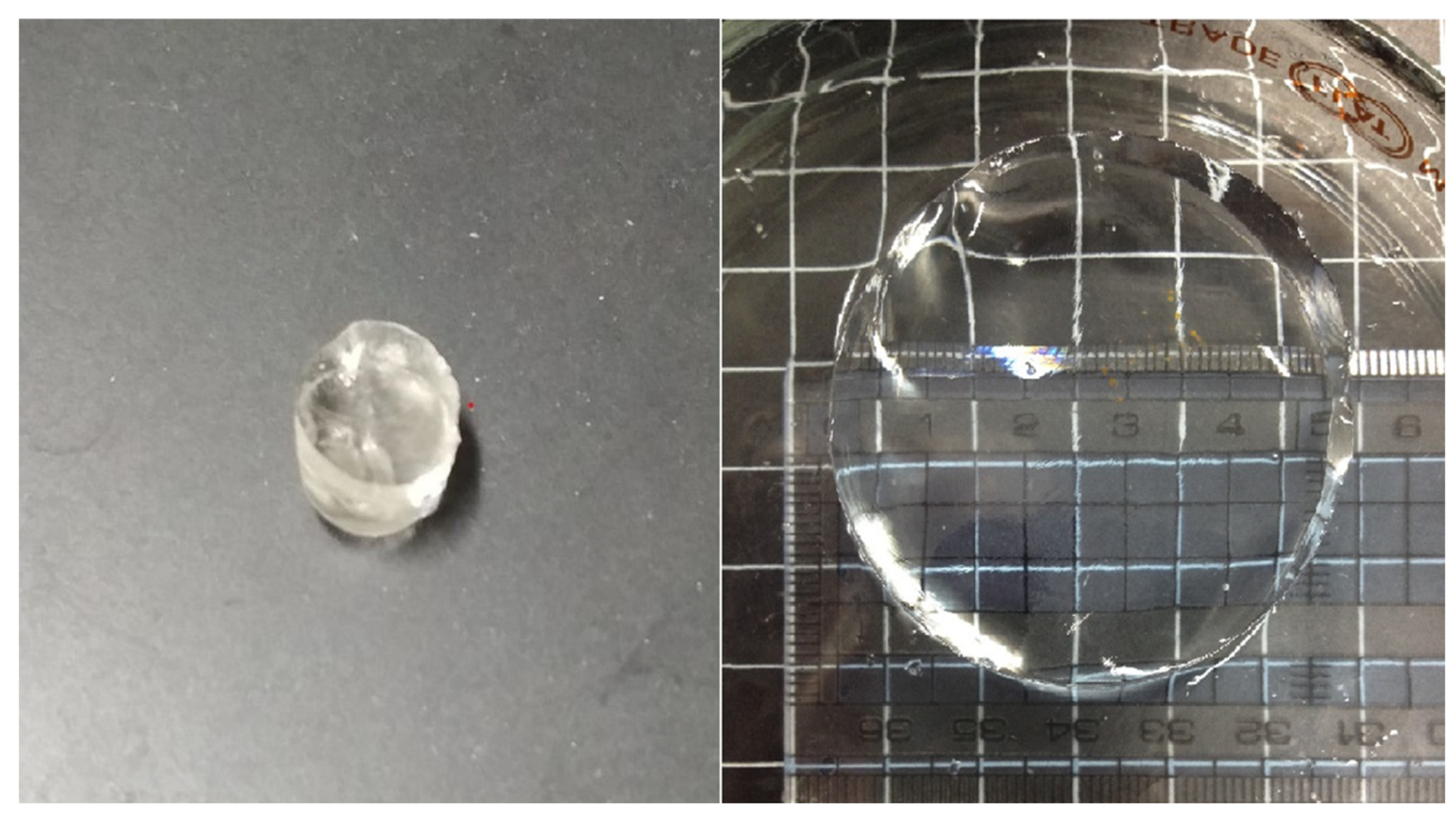

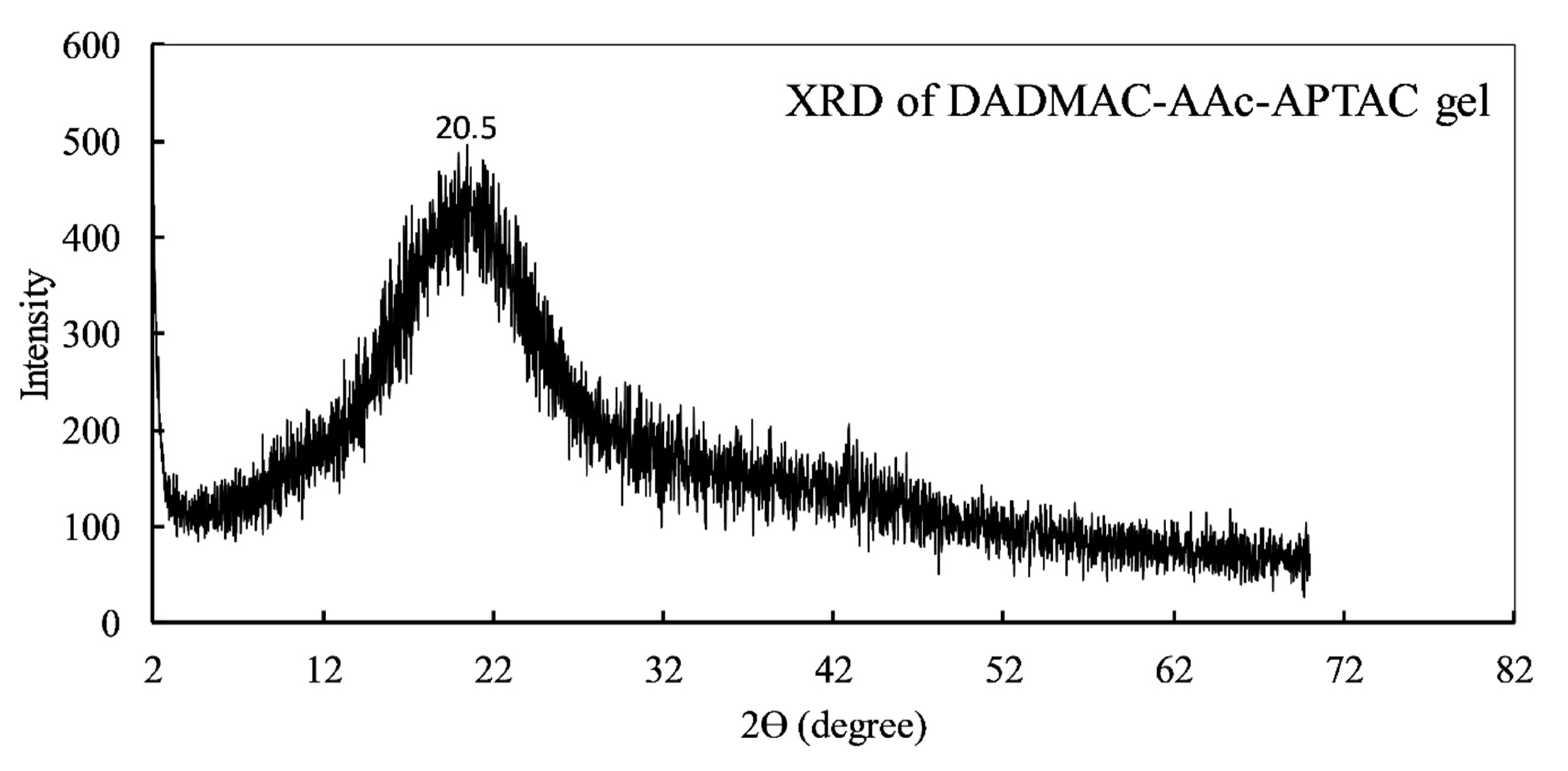
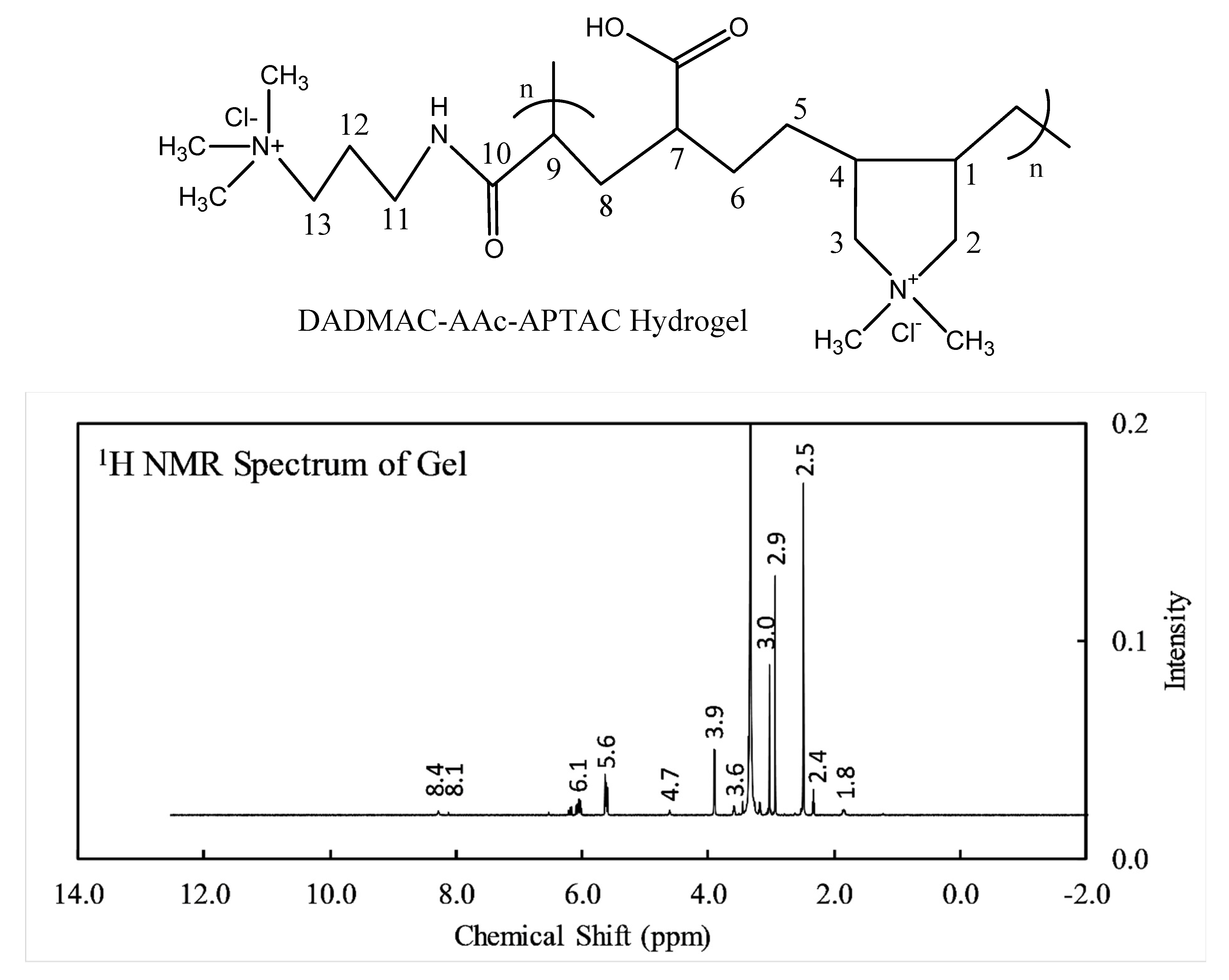
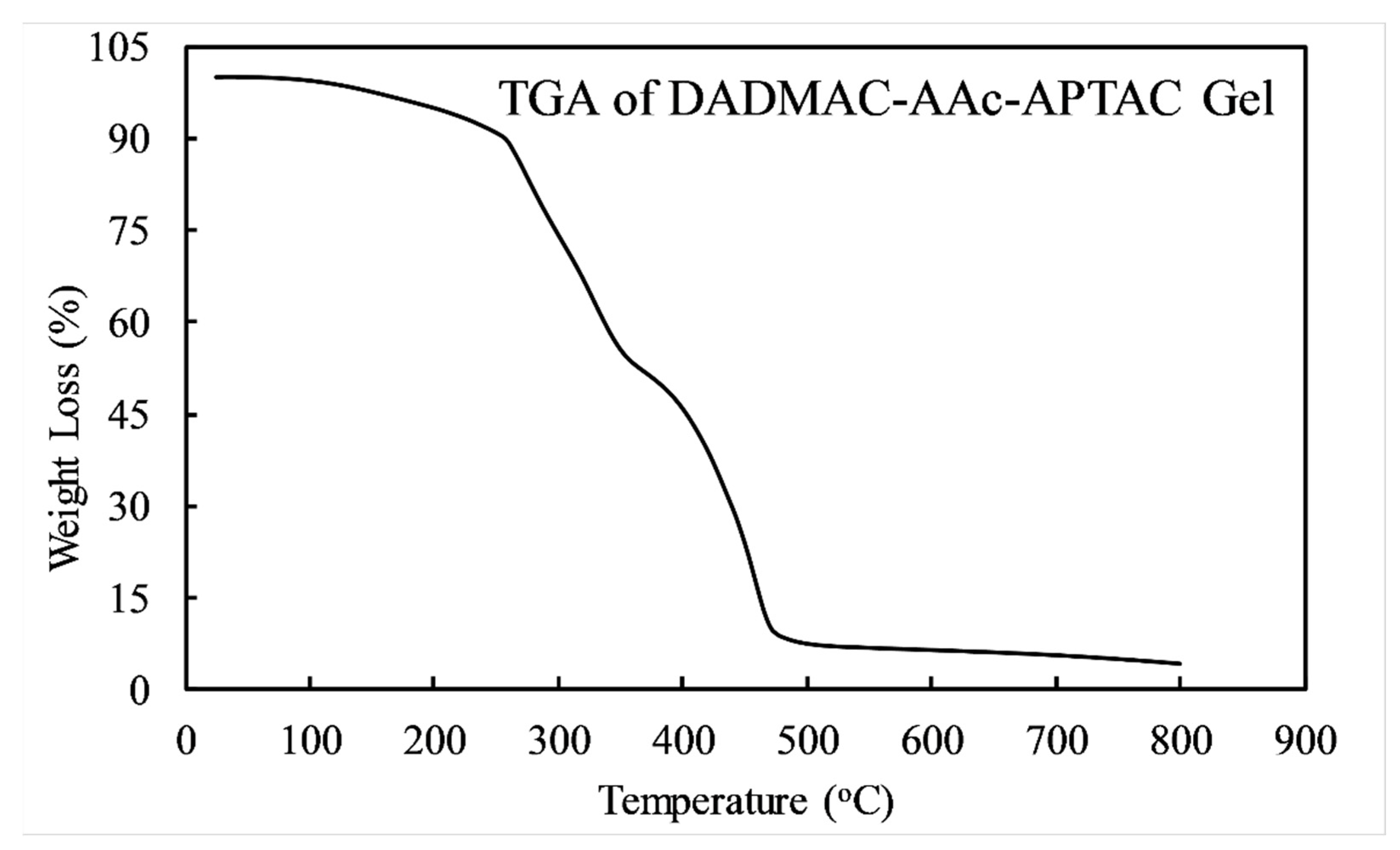
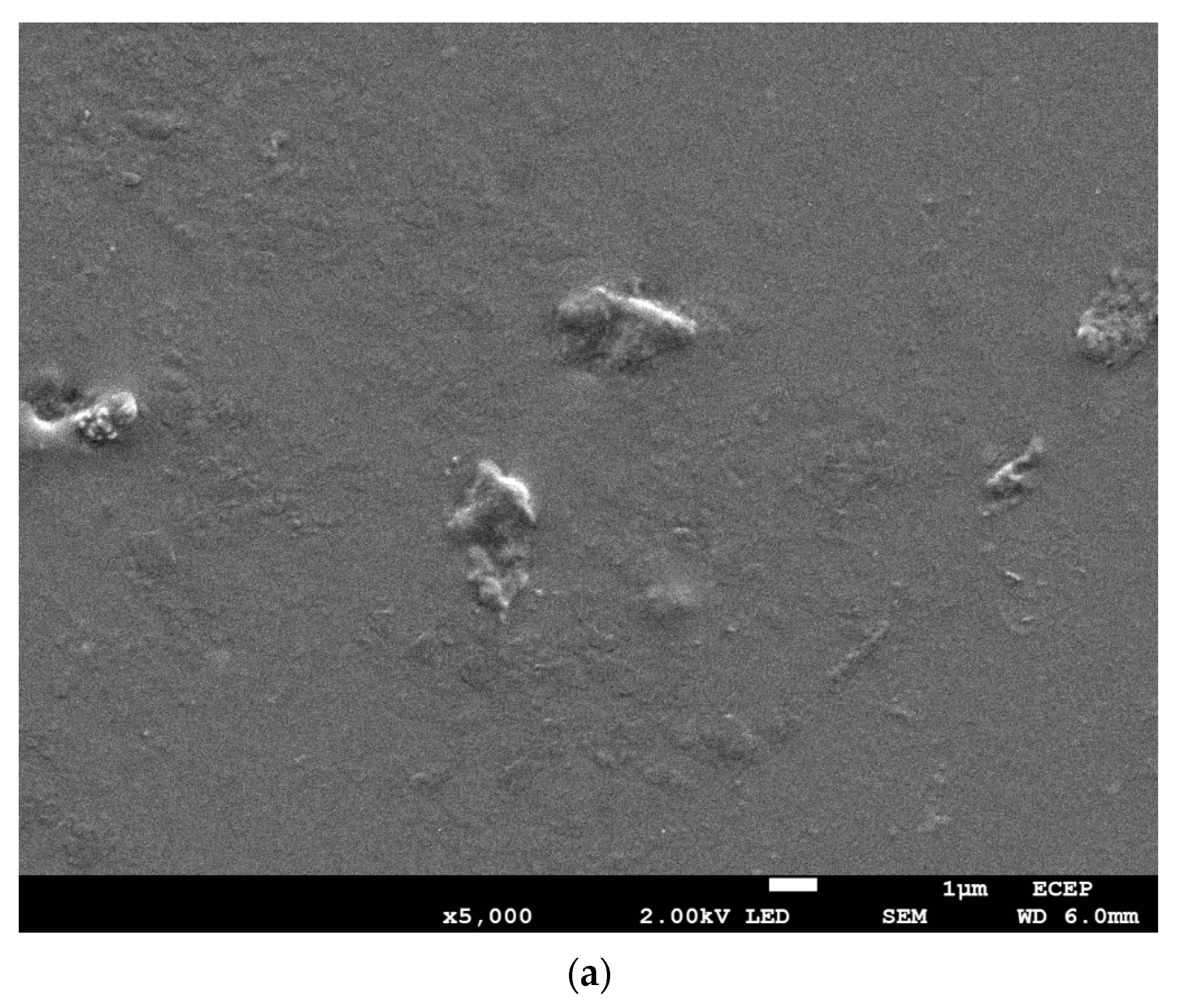
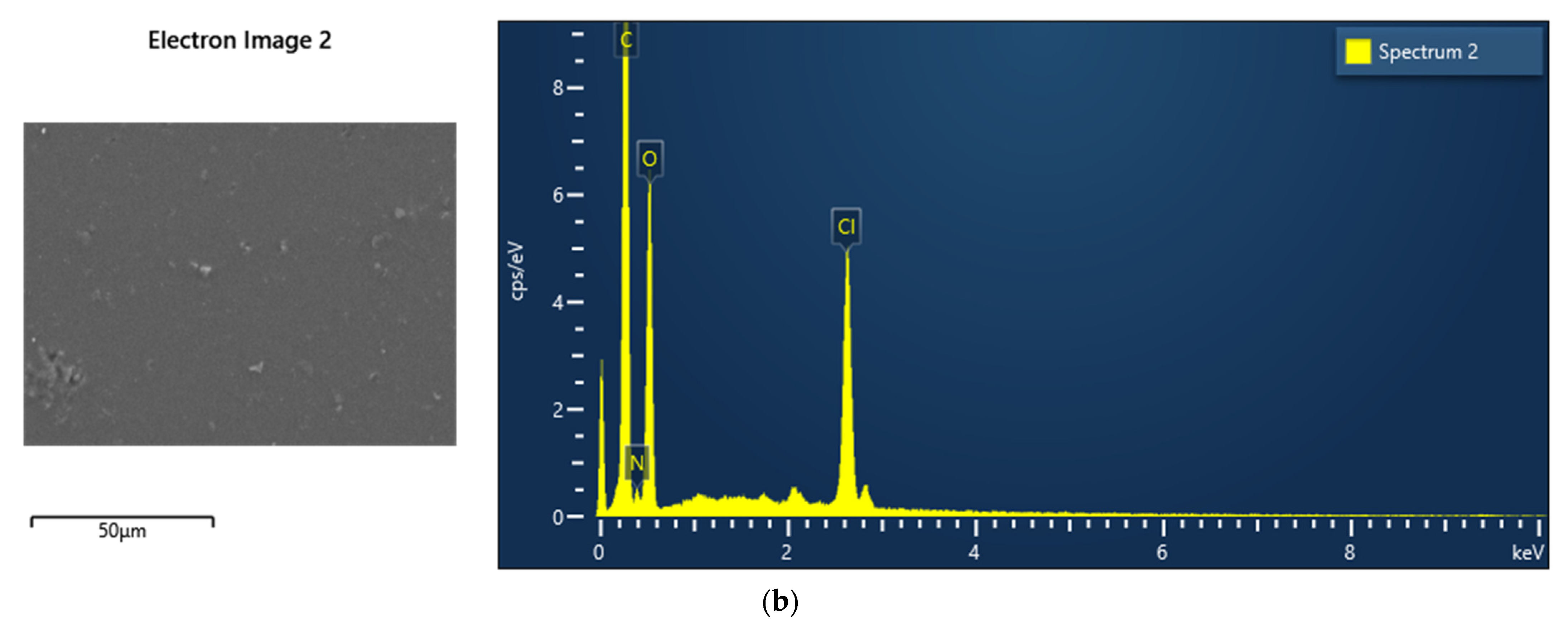
| Element | Weight % | Weight % Sigma |
|---|---|---|
| Carbon (C) | 59.15 | 0.59 |
| Nitrogen (N) | 7.55 | 0.76 |
| Oxygen (O) | 28.38 | 0.40 |
| Chlorine (Cl) | 4.92 | 0.08 |
| Total: | 100 |
| Composition of Raw Materials | Observation |
|---|---|
| DADMAC (10%) + APTAC (10%) | No hydrogel found |
| DADMAC (10%) + AAc (10%) + APTAC (10%) | Solid Hydrogel found |
| DADMAC (10%) + AAc (5%) + APTAC (10%) | Solid Hydrogel found |
| Radiation Dose (kGy) | 2 | 5 | 10 | 20 | 30 |
|---|---|---|---|---|---|
| Gel Product | Solid gel | Solid gel | Solid gel | Solid gel | Solid gel |
Disclaimer/Publisher’s Note: The statements, opinions and data contained in all publications are solely those of the individual author(s) and contributor(s) and not of MDPI and/or the editor(s). MDPI and/or the editor(s) disclaim responsibility for any injury to people or property resulting from any ideas, methods, instructions or products referred to in the content. |
© 2023 by the authors. Licensee MDPI, Basel, Switzerland. This article is an open access article distributed under the terms and conditions of the Creative Commons Attribution (CC BY) license (https://creativecommons.org/licenses/by/4.0/).
Share and Cite
Bhuyan, M.M.; Jeong, J.-H. Synthesis and Characterization of Gamma Radiation Induced Diallyldimethylammonium Chloride-Acrylic Acid-(3-Acrylamidopropyl) Trimethylammonium Chloride Superabsorbent Hydrogel. Gels 2023, 9, 159. https://doi.org/10.3390/gels9020159
Bhuyan MM, Jeong J-H. Synthesis and Characterization of Gamma Radiation Induced Diallyldimethylammonium Chloride-Acrylic Acid-(3-Acrylamidopropyl) Trimethylammonium Chloride Superabsorbent Hydrogel. Gels. 2023; 9(2):159. https://doi.org/10.3390/gels9020159
Chicago/Turabian StyleBhuyan, Md Murshed, and Jae-Ho Jeong. 2023. "Synthesis and Characterization of Gamma Radiation Induced Diallyldimethylammonium Chloride-Acrylic Acid-(3-Acrylamidopropyl) Trimethylammonium Chloride Superabsorbent Hydrogel" Gels 9, no. 2: 159. https://doi.org/10.3390/gels9020159
APA StyleBhuyan, M. M., & Jeong, J.-H. (2023). Synthesis and Characterization of Gamma Radiation Induced Diallyldimethylammonium Chloride-Acrylic Acid-(3-Acrylamidopropyl) Trimethylammonium Chloride Superabsorbent Hydrogel. Gels, 9(2), 159. https://doi.org/10.3390/gels9020159







